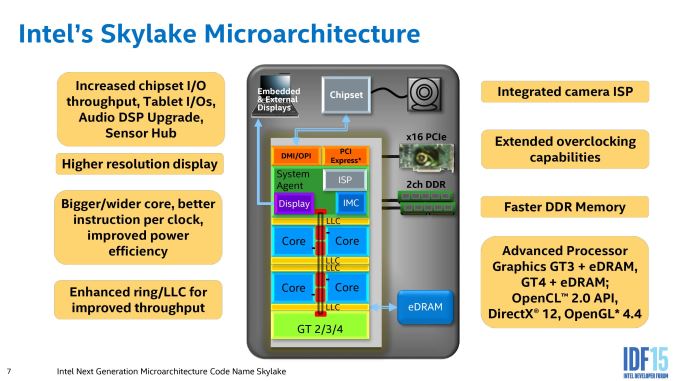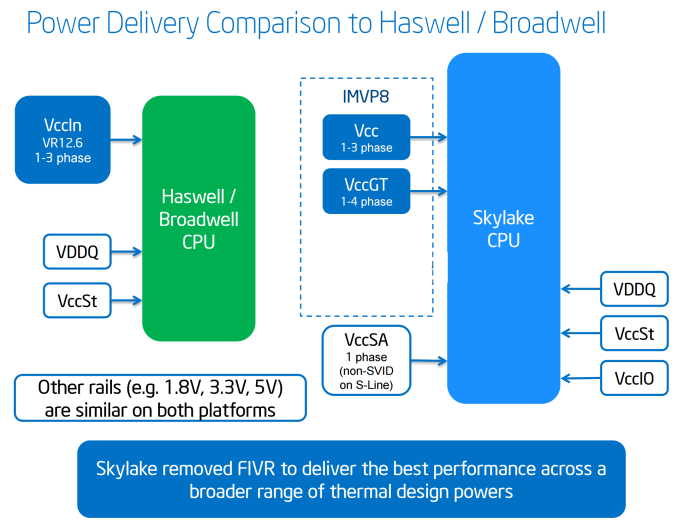The Intel Skylake Mobile and Desktop Launch, with Architecture Analysis
by Ian Cutress on September 1, 2015 11:05 PM ESTA small portion of this page was posted as part of our initial Skylake-K coverage.
The High Level Core
Taking a high level view, the application of the Skylake-S/H architecture features results in the following:
From most perspectives, the central image provided by Intel could have been taken from a Broadwell presentation if you scrubbed out the ‘GT4’ element of the design, but the move to Skylake suggests improvements in each of these areas either in terms of functionality, bandwidth, power consumption, or all of the above.
Out of the box, the Skylake IA core is designed to extract instruction level parallelism from code, and the design allows for more operations to be dispatched, queued and retired in a single clock. We cover this more in the next page. But to augment this, the data transfer ring between cores, cache, graphics and the system agent is also increased in read bandwidth to 128b, allowing more data to be supplied to the cores. In terms of the cores themselves, the big upgrades surround in-flight management of data, especially with respect to cache misses. We have been told that a number of these upgrades, while they might not be readily usable by current software, should have effects in certain vertical markets (finance, big data, etc).
From a memory connectivity standpoint, most processors will support both DDR3L and DDR4 with a dual memory controller design (or a single memory controller that supports both). Skylake-Y (Core M) is the exception here, and will only work in DDR3L/LPDDR3 modes. As always with multi-DRAM support designs, only one standard can be in use at any time.
On the PCI-Express Graphics allocation side, the Skylake-H and Skylake-K processors will have sixteen PCIe 3.0 lanes to use for directly attached devices to the processor, similar to Intel's previous generation processors. These can be split into a single PCIe 3.0 x16, x8/x8 or x8/x4/x4 with basic motherboard design. (Note that this is different to early reports of Skylake having 20 PCIe 3.0 lanes for GPUs. It does not.)
With this SLI will work up to x8/x8 and CrossFire to x8/x8 or x8/x4/x4 in both desktop and mobile designs. For desktops, if a motherboard supports x8/x4/x4 and a PCIe card is placed into that bottom slot, SLI will not work because only one GPU will have eight lanes. NVIDIA requires a minimum of PCIe x8 in order to enable SLI. Crossfire has no such limitation, which makes the possible configurations interesting. Below we discuss that the chipset has 20 (!) PCIe 3.0 lanes to use in five sets of four lanes, and these could be used for graphics cards as well. That means a motherboard can support x8/x8 from the CPU and PCIe 3.0 x4 from the chipset and end up with either dual-SLI or tri-CFX enabled when all the slots are populated.
For Skylake-U/Y, these processors are not typically paired with discrete graphics and as far as we can tell, the PCIe lanes have been removed from these lines. As a result, any storage based on PCIe (such as M.2) for devices based on these processors will be using the chipset PCIe lanes. As mentioned later, the chipsets on U/Y also differ to their more desktop oriented counterparts.
DMI 3.0
The Skylake-S and H processors are connected to the chipset by the four-lane DMI 3.0 interface. The DMI 3.0 protocol is an upgrade over the previous generation which used DMI 2.0 – this upgrade boosts the speed from 5.0 GT/s (2GB/sec) to 8.0 GT/s (~3.93GB/sec), essentially upgrading DMI from PCIe 2 to PCIe 3, but requires the motherboard traces between the CPU and chipset to be shorter (7 inches rather than 8 inches) in order to maintain signal speed and integrity. This also allows one of the biggest upgrades to the system, chipset connectivity, as shown below in the HSIO section.
Skylake-Y/H, by virtue of having the chipset on the processor package, can keep the interface between the CPU and IO very simple and uses what they call an OPIO – on package input-output. We have seen this as far back as Haswell to deliver 4GB/s of bandwidth at 1pJ/bit, and has been listed as being very power efficient as well as highly scalable.
CPU Power Delivery – Moving the FIVR
Moving on to power arrangements, with Skylake the situation changes as compared to Haswell. Prior to Haswell, voltage regulation was performed by the motherboard and the right voltages were then put into the processor. This was deemed inefficient for power consumption, and for the Haswell/Broadwell processors Intel decided to create a fully integrated voltage regulator (FIVR) in order to reduce motherboard cost and reduce power consumption. This had an unintended side-effect – while it was more efficient (good for mobile platforms), it also acted as a source of heat generation inside the CPU with high frequencies. As a result, overclocking was limited by temperatures and the quality of the FIVR led to a large variation in results. For Broadwell-Y, this also resulted in an increase for the z-height of the processor due to having leveling transistors on the rear of the package. As a result, in order to decrease the z-height of any corresponding product, a hole in the motherboard had to be forged:
For Skylake, the voltage regulation is moved back into the hands of the motherboard manufacturers. This should allow for cooler processors depending on how the silicon works, but it will result in slightly more expensive motherboards.
A slight indication of this will be that some motherboards will go back to having a large amount of multiplexed phases on the motherboard, and it will allow some manufacturers to use this as a differentiating point, although the usefulness of such a design is sometimes questionable.













173 Comments
View All Comments
Le Geek - Wednesday, September 2, 2015 - link
Anything>>muchMrSpadge - Wednesday, September 2, 2015 - link
Well, for me the mobile quad's are totally uninteresting, be it i5 or i7. I'm rather interested in what you can get out of the 6700 iwth a Z170 board.Anyway, I second the request for an efficiency investigation. The 6700K started at insanely high stock voltages, so now onder it's not better than Haswell in this regard. AT also showed some numbers with optimal core voltage, but those start at 4.3 GHz and 1.20V. Which says nothing about any of the other chips, even in stock configurations (i.e. without undervolting).
dtgoodwin - Wednesday, September 2, 2015 - link
I also add my request. Based on Intel's comments, those tests likely need to be redesigned to approximate real world usage, not user tasks, then recorded and played back as fast as possible. I'd love to see efficiency from typical desktop usage, gamer, home theater, and "enthusiast". I'm sure you have several users that recordings could be taken from and played back to simulate these. Yes, the tests would take longer to perform, but it appears that's going to be a requirement to achieve accurate efficiency tests at this point.MrSpadge - Wednesday, September 2, 2015 - link
Measuring response times might be crucial for such tests, as the throughput might not be the most important metric any more. All tasks will have finished before the end of the benchmark, if played back slowly enough.vred - Wednesday, September 2, 2015 - link
"Secret source" = "secret sauce"?jjj - Wednesday, September 2, 2015 - link
Hard to care at this point given how little they offer and at what prices.The core does seem to be rather big and far too big for low W- perf per area is very very low there. Core M is still insanely priced given how little it does. Was wondering if they'll do a hard price cut ahead of A72 SoCs since at that point it will be a lot easier for folks to realize how absurd Intel's pricing is..
A few days ago noticed a little board with a quad A7, 1GB RAM and plenty of connectors for just 15$. That kind of computing device makes you wonder about where the world would be if we weren't stuck on Wintel. The premium this monopoly adds to PCs is heartbreaking at this point. At least in mobile things are ok for now.
extide - Wednesday, September 2, 2015 - link
Core m is on the order of 10x the performance of a Quad A7. Core m is also a pretty small die, it is a similar die size to mobile SoC's. Not sure what you are talking about ... it's a different product for a different price.bji - Wednesday, September 2, 2015 - link
I'm pretty sure Intel intentionally gimped the thermal performance with inferior TIM underneath the heat spreader. I believe this is a ploy to allow them to release a part with improved TIM some time down the road as a new, higher clocking revision. I think this is a way to gate performance intentionally so that the can sell essentially the same part over several releases.Without significant competition from AMD, this is the kind of thing that Intel can unfortunately get away with.
bji - Wednesday, September 2, 2015 - link
http://www.overclock.net/t/1568357/skylake-delidde...This thread gives good evidence that the part would clock much better with better TIM.
0razor1 - Wednesday, September 2, 2015 - link
Second that